Critique/ Fundamentals Practice
-
Hey everybody name's Leo. I'm new to the forum and relatively new to art in general and was hoping for some advice. I've been drawing off and on for the past year and a half, but in the past month or so I've really been taking it seriously, trying to practice and just draw everyday.
I've been listening to 3PP and a number of times they mentioned to make sketchbooks just got say perspective or shape and form, the fundamentals. So if I could get some help : first some critique on some recent drawings I've done. When I look at them I like them alot but I also know they could use ALOT of work but I'm not sure how. Any help would be appreciated.
Second how can I practice the fundamentals? I feel like it's a weird question and maybe it is, maybe the answer is just do it, but if anyone has some resources or books( I know SVS has some classes which I'm definitely interested in but I can't buy the subscription at the moment) on how to practice perspective and line weight, proportion, design, concept, composition things like that. I would really appreciate it. Thanks for your time guys
Edit: I don't remember clicking on 3PP for the category when I made this so I apologize about that. SHould be in Artwork or Question...
-
This one I made after putting a bunch of descriptive words such as crime, fantasy, 1940s, and sci-fi in a box, shaking it up and then picking 3. I pulled out Sci-Fi, Western and Evil Monster. I didn't really stick to the Evil Monster or really the western prompt but it helped spark this drawing and that was the purpose, just to get some ideas flowing.
 image url)
image url) -
This one I did from a #drawthisinyourstyle from Creature box on instagram.

-
Hello Leo!
I took a little bit of time to check out your instagram, and I must say your tenacity towards staying in the habit of drawing seems to be developing well. I saw you got halfway through Inktober, which is waaay better than my first year.
Speaking of that first year, I have some advice for you, because what will trip you up more than anything is assuming that going through the motions-- merely putting pencil to paper and making sure your shapes are right and drawing to make sure something looks right-- will carry you through to the end. Sometimes engaging in that mindset is exactly what you'll need to get going on understanding how to draw, but often it's a little bit of a trap. It was my first year of Inktober that my mindset was exactly like that, but it wasn't until I started picking up the fundamentals that things became much easier.
The first thing you need to understand about understanding how to draw is that the best artists, from my student's perspective, is about understanding what makes things work: stuff like the physiology of your arm when you're drawing, or the rule of thirds, or color theory principles.
Start with this: try drawing a perfect circle with one stroke. If you're anything like I was in my first year drawing class, your circles will be all skillywonk, because at the start of my first session I had a lot of trouble doing shapes like that. My art teacher told me, however, that by not moving the wrist and instead making circular motions using the upper arm and keeping the forearm relaxed, drawing more perfect circles was not only easier to do, but it was a lot quicker. This is the concept of gestural drawing: using the body's natural capacities to move and understanding what will do what, like how holding the forearm and wrist makes drawing circles easier. I should say that SVS's "How to Draw Everything" course goes over the exact same stuff, with demos at the end to demonstrate how the concepts work.
Physiology is only one half of the battle, however, and the other is understanding fundamentals. Thankfully, fundamentals are the things you can discover and pick up by observation. What I mean to say is that the theory of drawing can be learned by watching people work, reading about how art works, and making general observations to see how principles are applied to already-finished work. Rule-of-thirds, for example, is something you can start observing in everything, and it's a fairly accessible-to-learn element of drawing and art in general.
All of this swirls together and coagulates to answer your original question like this: you need to look at work, and you need to make work. You can hear a million theories on how art and illustration works, but unless you just go and make pieces, you won't be able to apply the principles you learn. If you're having trouble absorbing it all, take it one principle at a time, yanno? If you're having trouble drawing objects, take a look at some simple objects and dissect how to draw them. Try getting together some simple objects and drawing them really well to start, and while you're doing those things, just think about the principles you've already learned. It's also important to pick up new concepts and to push yourself at the beginning, especially if you've not got anyone else to push you.
Well! I did not intend to write the wall of text I just wrote, but I hope it works out! Stick with it, man, you'll get better as you go, for sure!
-
Hi @leothejediartist welcome to the forum! Ok, first off, I'm no expert but am also a beginner trying to figure it all out on my own.
One of the things I learned early on is that just drawing without a learning goal in mind just kept me stuck wondering why I was not improving. So I started to set myself mini goals based on my weaknesses ,which to be honest is everything! I started with figuring out what are the fundamentals - cos I had a vague notion but not a list - I needed a list! Then I set myself a task to practice just that for a week or a month or whatever depending on how much I thought I was crap at it. Couldn't draw a straight line or a circle or an ellipse consistently when I first started - still do that practice every morning as a warm up.
When I started to get bored, I would pick someone who was good at line (like Jake) and copy their work for more practice, then try it on my own. Still not good at it and progress is slow but I keep adding more fundamentals to my learning mix and am slowly building my skills.
Before I stumbled on SVS, I learned quite a lot of stuff from youtube - Will Terry's channel has good stuff and Jake Parker's, also Bobby Chui has some good stuff on basics and Stephen Silver if you are into character design. So many options, it can be overwhelming.
As for books - depends what you are hoping to do - I realized I like the cartoony, style characters of animation and the watercoloury painting style of Beatrix Potter so I looked for books that could help me learn how to do things that way.
But my overall advice, for what it is worth, is don't just watch and read stuff without a specific learning goal in mind - what do you want to improve on this month . And be patient - it takes time for your brain and hand and eye to get rewired to work together for this stuff. I noticed periods where it seemed I just didn't get it and felt like an idiot - then suddenly poof! my hand was drawing the line I wanted it to draw and it seemed like magic. Then the next day I sucked again and had to start over.
Anyway, sorry for the long rambling post - good luck with it and look forward to seeing more of your work! -
Welcome to the forum. Learning the fundamentals is key, and I think the most important one to learn when starting out is perspective as it pertains to literally everything in art. There is a really good YouTuber I came across a while back, Marc Leone, and he has an entire series on every type of perspective, how to learn it and put it into practice. Also, judging by your name I assume you like Star Wars and a lot of his perspective demonstrations involve Star Wars.
Here is a link to that play list -- https://www.youtube.com/watch?v=5orI-eYOPys&list=PLMXbAPr21di8DjTKCE3EoS4KFtNZ-FDnP&index=1
Hope this helps and best of luck to you.
-
Looking good mate. https://drawabox.com/ is a great free resource to learn fundamentals. He has also thrown in some great tutorials on composition and environment.
Unfortunately, he removed the lessons on the figure, but there are plenty of other resources out there.
-
@jabbernewt Thank you very much for the reply. Really appreciate the advice. I'll work at the full arm movement which sounds familiar but I'll really try to implement it. Some time soon I hope I can purchase the how to draw everything class. Again thanks for the time

-
@missmushy I do feel I've got a good handle on drawing everyday so I should try to add some more goals. Thanks for the tip. I'll also check out those other YouTubers, I follow Jake Parker and will Terry, so I'll definitely give the others a look. Thanks for your time, I appreciate the advice and encouragement

-
@buddy-skelton 3 hour video
 lol I'll get on it. Thank you
lol I'll get on it. Thank you  I do feel perspective is a weakness do this will definitely be helpful
I do feel perspective is a weakness do this will definitely be helpful -
@concept after browsing a few minutes that looks really good. Thanks for the site man.

-
Hey Leo,
Classes and books can definitely be expensive. I would suggest visiting your local public library and just checking out everything they have to offer in the art section on drawing. Some ones I really like from personal experience:
-Picture this by Molly Bang (for composition). Very simplified but makes valid points
-Drawing on the right side of the brain by Betty Edwards (general drawing) Full of neat exercises to expand your perspectives
-Color and Light by James Gurney possibly the best book you could ever use - really comprehensive once you get to that point
-Any sort of "classical anatomy for artists" type booksAlso any book from Andrew Loomis - an excellent illustrator who had a tendency to make things really understandable/digestible. These are really old so you can maybe even find these available as free pdfs online (or send me your email and I can send them to you).
Additionally sketching from life is so important, whether that means going to local life drawing sessions and pitching in a few bucks towards the model or doing landscapes and still life drawings. Learning the rules and fundamentals helps you break and warp them if you want to stylize things later on.
-
@leothejediartist that 3 hour video is just number one of 37!! Lol. But if you are serious about it then it should really excite you because trust me, finding people that go into that much detail and depth for free is hard to find.
You don't have to sit there and just watch, if you follow along with your sketch book (which I would encourage) or photoshop or whatever you feel comfortable with then you will gain tons of "mileage" which most artists say is just as important as knowing the technique. It's getting that muscle memory and that flow through your arm to make confident strokes in whichever medium you try.
And that goes for any resource you find, you can't just read or watch it, you have to put in the work with it.
Good luck!
-
Hi Leo! I have a few thoughts on studying fundamentals.
First I think it might be good to brush up on some observation techniques that will help you with proportions and relationships when you study from life or from reference. It will help streamline the process of learning other fundamentals. Jake Parker's "How to Draw Everything" and Betty Edward's "Drawing with the Right Side of Your Brain" will help you in this area and here are some free, simple, and short videos that also deals with observation techniques.
https://www.ctrlpaint.com/videos/visual-measuring
https://www.ctrlpaint.com/videos/visual-measuring-proportion
https://www.ctrlpaint.com/videos/gesture-drawing-spoons
https://www.ctrlpaint.com/videos/drawing-shape-contour
https://www.ctrlpaint.com/videos/drawing-shape-linear-block-in
https://www.ctrlpaint.com/videos/drawing-shape-negative-spaceI also would recommend learning the basics of perspective almost from the get go. Perspective will not only help you with constructing scenes, but it will also help you with making characters, objects, and implementing light and shadow. Learn 1 point and 2 point perspective and 3 point. Learn about ellipses in perspective. Learn about drawing cubes, cylinders, cones, and spheres in perspective. Learn about sculpting techniques for perspective- additive, subtractive, footprint, curves, and cutting holes. Learn about scaling and spacing. After you've spent some time doing basic perspective, learn how to construct drawings out of larger simple masses, following rules of perspective where applicable, and then adding contours and details on top.
Others have given you great resources. I will also recommend the draw-a-box website and Andrew Loomis' "Successful Drawing" I have a few others that I think are good for starting out with fundamentals.
- How to Draw What You See by Rudy De Reyna
- Perspective Made Easy by Ernest Norling
- https://www.ctrlpaint.com/library/. He has free content and paid content. If you look at the free content, look at the free video library section. Sections 2, 3, and 7 may be good places to start for fundamentals.
- Drawsh.com It has good complements to many fundamental concepts.
When I study fundamentals, I try to do 2 things to get a well rounded approach:
-
Observe and Copy- From your learning material, life, photographs, and other artwork. This includes many types of exercises. For example, if I'm studying constructive drawing I might: Copy straight from the source material. Look at photographs of different objects, identify their major masses, trace over them and add cross contouring. Look at my couch in real life, sketch it by breaking it down into simple shapes and making sure I'm following the rules of perspective. Taking an illustration I admire, and do a sketch of it, just utilizing simple 3d shapes. The point is to observe and interact with the concepts in many different ways.
-
Apply: Make your own drawing or artwork using the concepts you have copied and observed in the first step. This does not have to be a finished illustration and can be a sketch, but the point is to make up your own thing. You can do it without reference or you can use reference as a guide if you want, but do not copy it- change the angle or add different forms, details, lighting, etc to it. So if I'm still studying constructive drawing, after I've drawn my couch from observation, I might draw a different couch-mostly from my imagination, drawing it in a different angle and adding different proportions and details to it.
The good news is that many of the resources listed by people here already have exercises that make you do these things anyway. If you come across a learning resource that does not make you observe and apply the principles being taught, you'll have to be proactive and make up your own exercises or seek them out in other places. Start simple and work toward more complex.
I'll show some of my sketchbook studies I did when I was starting on my fundamentals. They show what I was doing to observe and apply. Looking at other people's sketchbooks really helped me, so I hope mine might be helpful to you.
Some with perspective. Copying source material and observing from reference and life.
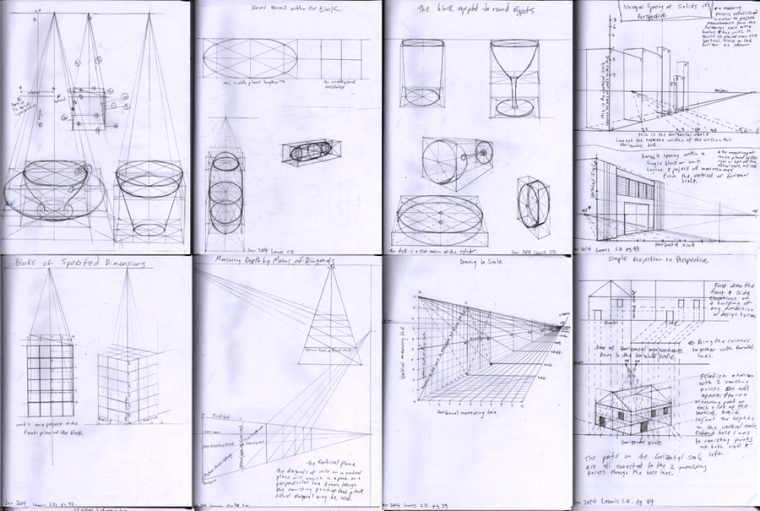
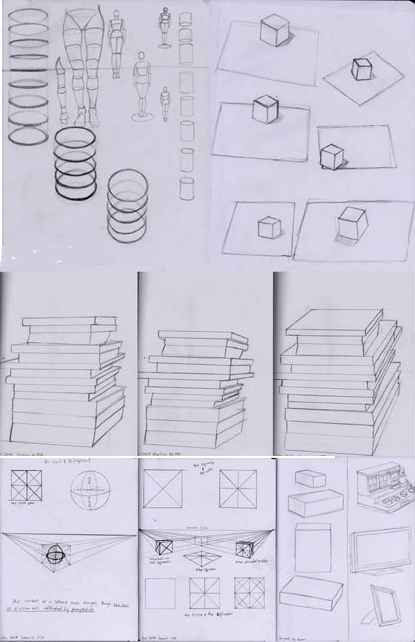
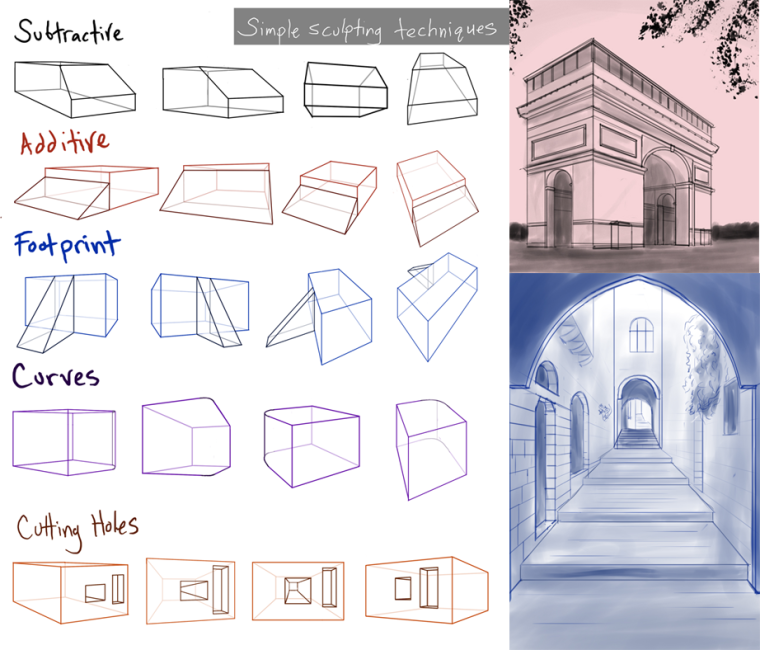
Applying the knowledge to made up studies
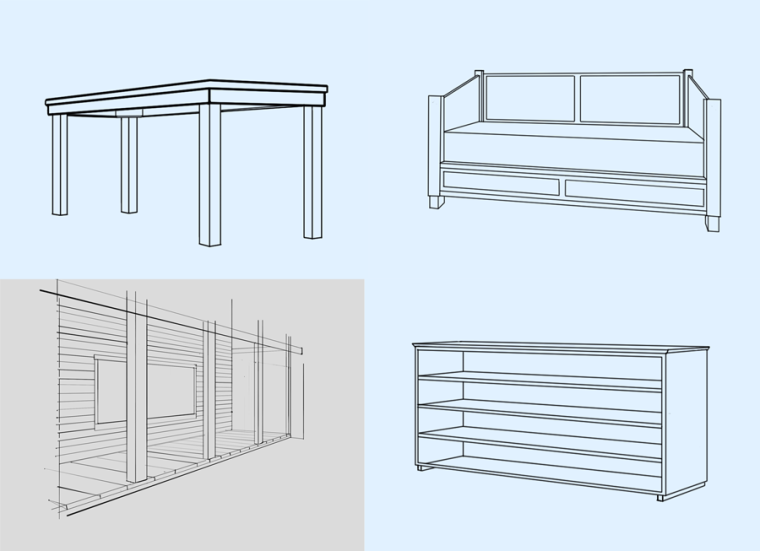
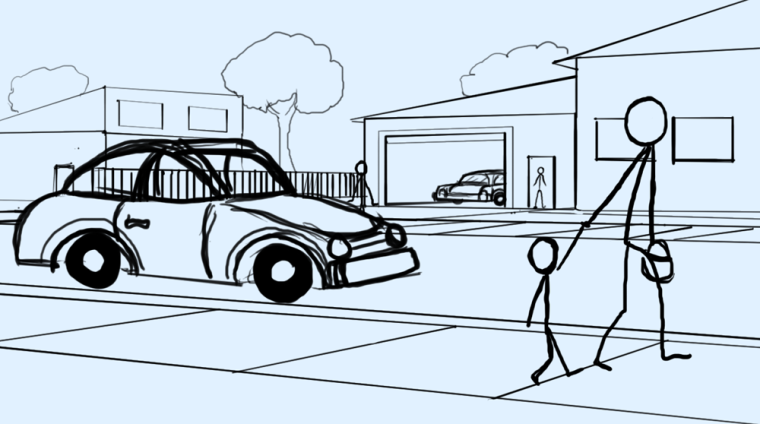
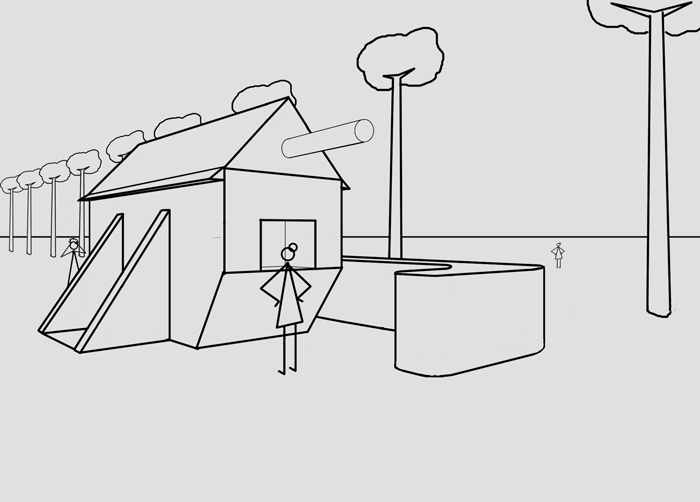
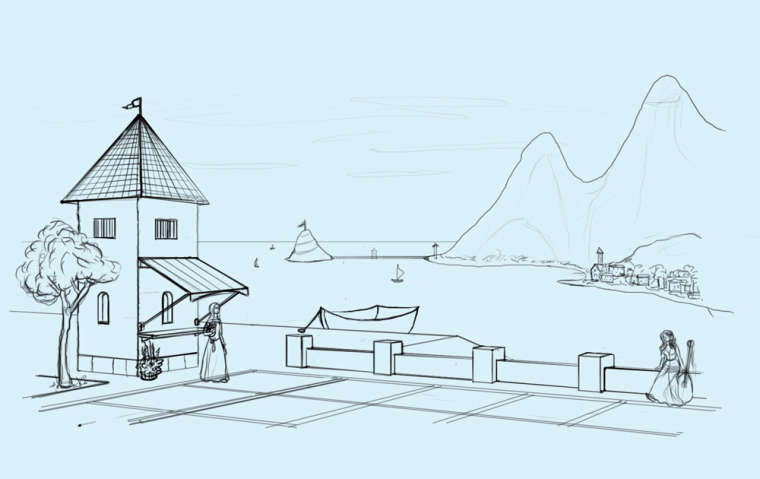
After I started studying perspective I started studying constructive drawing. Some of it was concurrent with my perspective studies as they go hand in hand.
Copying from learning sources, Observing from photo reference and real life. Starting with big shapes, adding details. Paying attention to perspective. Starting with simple objects, going to more complex.
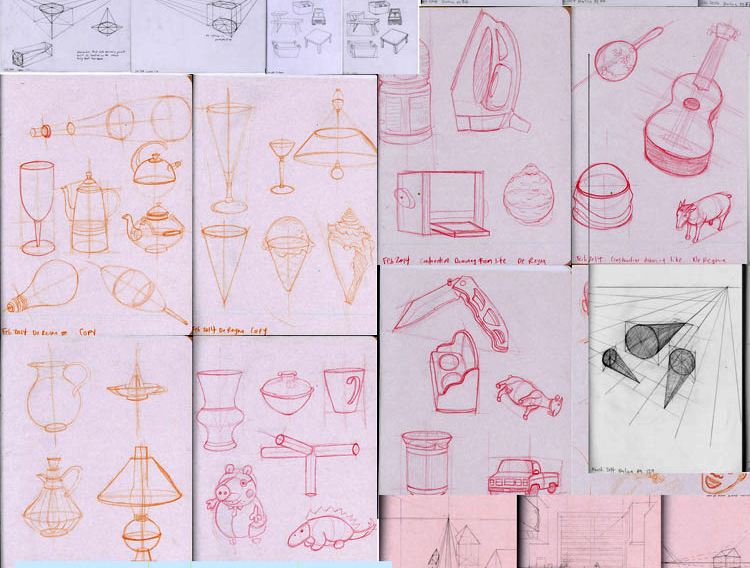
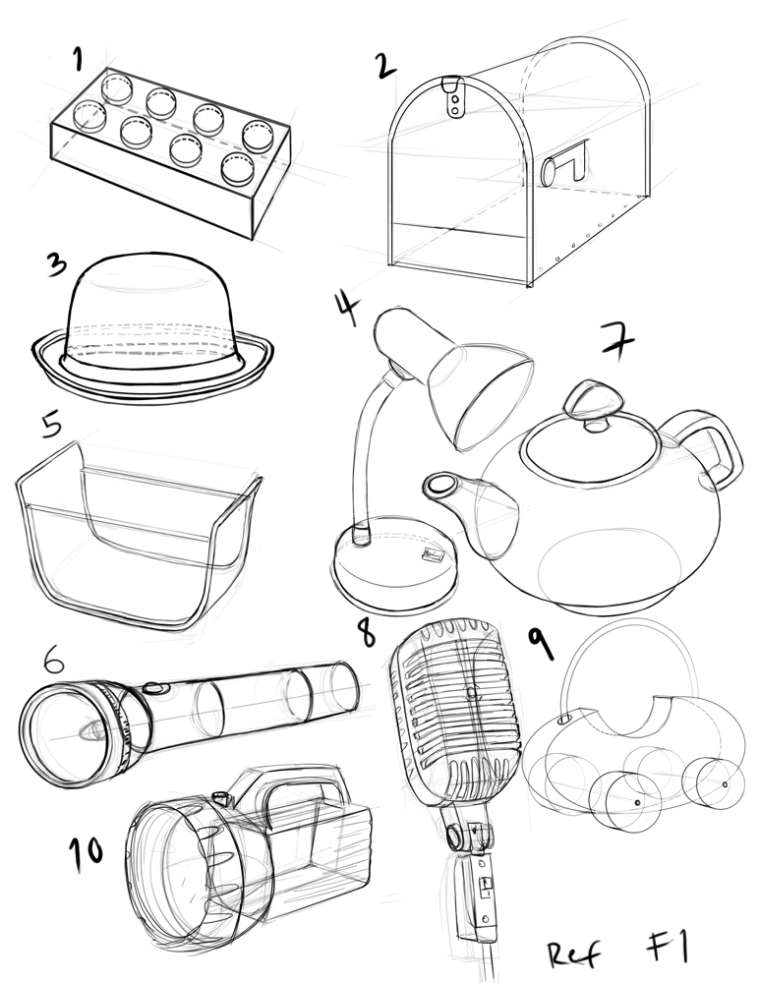
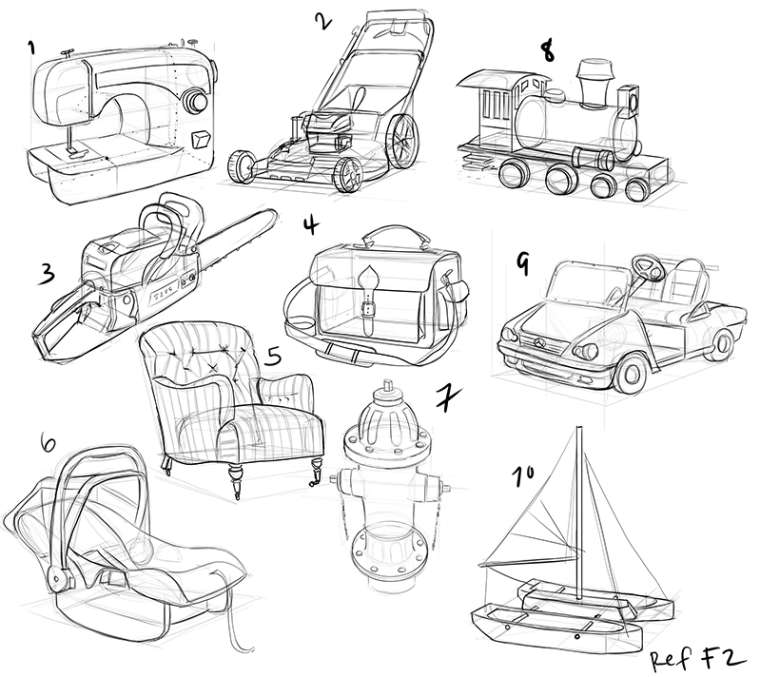
Applying the knowledge from my observational drawings. I constructed the basic shapes without reference, and only looked at reference to help me with aspects of the details.
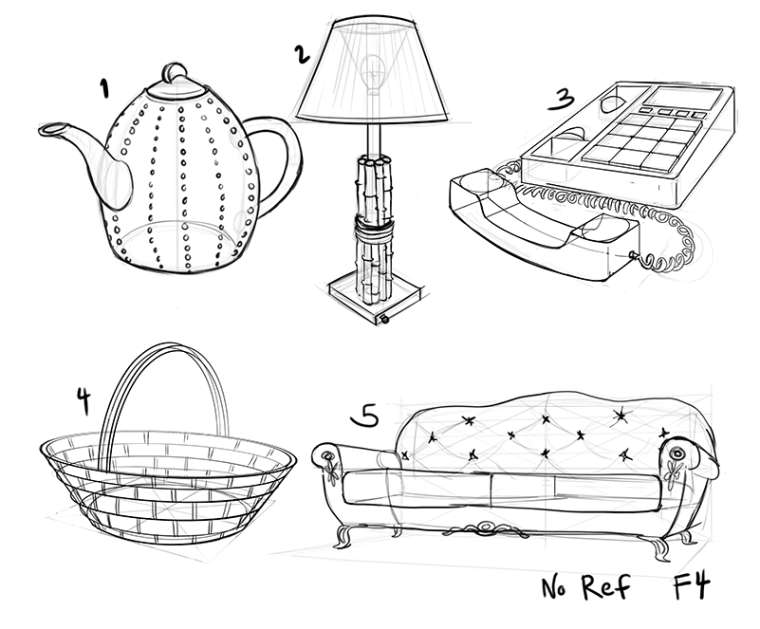
Working to more complex, I constructed still life arrangements from reference.
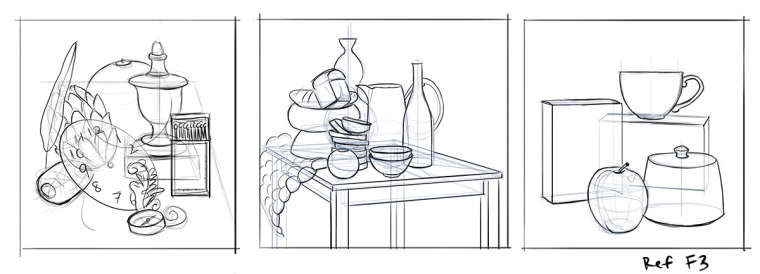
I applied the knowledge from the last study and made up a still life with no reference.
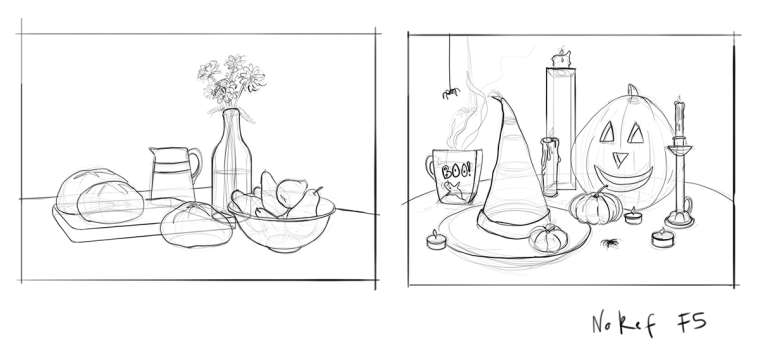
Anyway, good luck! It can be hard to know what to study and how study effectively. I hope you find something that works for you!
-
@juliekitzes @TessaW thank you very much for all this info. Didn't quite expect this much response lol. I will start hitting the books and videos.
Thanks for the sketchbook pics. It's interesting to see how others practice. Especially with perspective

-
@TessaW thanks for the advice you and everyone else provided. It's much appreciated and I hope I'll put it to good use.
I wanted to ask something about the drawing studies you posted here. The first ones and even later ones are done through use of a ruler? Am I correct? This is the way it should be done right? You can't possibly get lines down correct by doing them freehand. Some instructors suggest that so you become accostumed to drawing beautiful, flowy lines but I don't think it's practical especially for a beginner studying perspective. What did you do when studying perspective? -
@tianlian Yes, I used a ruler for most, but not all of my studies until I got more comfortable with perspective. My rational for that was that perspective was so overwhelming and at times confusing, that I didn't want to have to deal with freehanding as well. I wanted my mind to just focus in on the concepts.
Additionally, I work digitally a lot and I use a regular old tablet. I find it difficult to freehand longer lines with a tablet, so I'm pressing shift a lot to get straight lines, and I used a straight-line extension for a while as well.
Now that I'm more comfortable with perspective, I rarely use a ruler while sketching in real life, though I wouldn't rule out using one (haha) if the occasion called for it.
-
@TessaW Oh tell me about it... Heck yeah it is confusing
Do you have any general tips about studying perspective? Or I don't know, things you wish you knew? Because I thought it was just rules I had to memorize, but in reality it's...one big hot mess and I don't know what I'm doing. -
@tianlian Oh man, it's hard remembering exactly how I navigated through all that information. First, I don't claim to be an expert on perspective, it's still a challenging at times, but it's easier to sort through now.
I also think it's important to put things into context. It's common to see someone who you feel is somewhat proficient in a certain area in art, and not fully understand how they got to that point. What helped me a ton was to learn what other people did, and what they went through to get to where they are. So apologies ahead of time. I don't want to sound like I know it all or that I'm narcissistic, but I want to share a little of my experience, as it's helped me when others have done it.
I had previously went to art school about 2003-2007, where I picked up some handy observational skills. I could make pretty good paintings from life, I could make ok paintings if I copied directly from a photo, and I picked up some color and painting skills, but ask me to make my own illustration, even of a very simple scene without perfect reference? I couldn't really do that and didn't know how to get there. I stopped doing art at all until the end of 2013 because of it, until I found some online sketchbooks of people who developed their imaginative skills. I started perspective and constructive drawing in Jan 2014. At this point I was very afraid that I wouldn't be able to understand perspective at all. I didn't think I was smart enough, but I took the leap just started plugging away. Since then, I've been learning when I can. I've done a lot of study, some good, some bad, and I've gone through periods where I don't do art at all. I don't think I did any art for a year's time when I was pregnant with my second kid! And I just recently had a months long break after moving. It wasn't until I started working through the subscription courses here in 2017 that I feel I was able to get more comfortable with applying perspective to my own work. The classes here really give you a good working method and a way to organize your image creation process in a way that helped me harness my perspective knowledge.
In retrospect I think I did some good things and some bad things, during this whole time period starting in 2014.
So with that being said, here is my personal experience with perspective. I'm repeating some of what I said in an earlier post on this thread, but oh well.-
You might think about studying constructive drawing at the same time. Constructive drawing goes hand in hand with perspective and I think they enhance each other. In my opinion, constructive drawing can feel a bit more intuitive. I studied both at the same time and I don't regret it.
-
Use more than one source to learn from. I think I used 3 books, one main online source, and countless youtube videos that I can't remember. I didn't just skim the books, or casually watch my online source, I really dug into those resources. I recommend more than one source, because they tend to explain things a little differently and it covers all your bases, and repeats some of the same information without it feeling too repetitive. You get different types of exercise ideas as well.
-
If you are a self-studier, think of it like you're taking a class in high school. In a high school course you might first take notes from your teacher's lecture and your textbook. Then you might have a homework assignment. After several lessons and homework assignments, you might have an exam that applies all the knowledge you've learned through lectures and homework assignments. Then you'll continue on with more lessons and homework assignments until another exam. So with studying perspective, start out with notes and copying the examples from your learning resource. Then give yourself a homework assignment(or more than one) that is fairly simple. After doing this for a while and completing several homework assignments, give yourself an exam where you do an image that combines a few different principles you've learned. Rinse and repeat. I wish I would have done this a bit more when I studied it. While I was good at the lesson and homework part, I wish I had given myself more "exams". I didn't really do much of my own work back when I first started, and I wish I did.
-
For your homework assignments, do studies from your imagination, do studies from life, and do studies from photographic or art reference. You'll ideally be using imagination, real life, and reference as you make more finished work, so it makes sense that you'd use all three to study as well.
- Doing exercises based on imagination is obviously good for developing your imagination skills and getting the theory down without worrying too much about other factors. This would be like drawing simple shapes, objects, or scenes in perspective with out using any reference, and later moving on to more complex things.
- Drawing from life helps you take the theories you're learning and observe them in action. You can see how proportion, placement and overlap works. The theories will also help you organize the things you see in real life, making them easier and faster to draw (eventually). It can also make the theories make more sense and you can get a better sense of an object's 3d forms, because you can easily change your point of view and see an object or a scene from different angles. As a side note, I remember learning all these perspective theories and then I'd draw something from real life, and my art buddies would bust me because I wasn't applying those theories. I'd learn about vanishing points and then for some reason, I wouldn't make my lines recede to a vanishing point in my real life drawing studies.
- Drawing from photographic and art reference really helps with filling in details. It also helps with how placement, proportion, and overlapping works in perspective on scenes that aren't easily accessible in real life. It can also help you figure out how to translate scenes withing a 2d format and play with different point of views and exaggeration of perspective that's different from what we see with our eyes.
-
You can take a break after you've gotten the hang of a few principles. For me personally I studied perspective and constructive form for the first time over a 3 month period and in retrospect I did a lot of pointless master studies in that time period as well that wasn't related to any theory I was learning. After those 3 months I couldn't stomach it anymore. I moved on to light and shadow- which actually was the perfect transition from perspective. It utilized and enhanced perspective knowledge and it made more sense because of the perspective knowledge I gained. Then after about 10 months or so, I went back and did another round of perspective and constructive form studies. I probably shouldn't have waited so long, but I didn't have much art time as it was, and I didn't know exactly what I should be doing anyway and was doing some other random helpful and not so helpful studies in that time.
-
It won't feel intuitive or easy when you start applying it to your finished illustrations. I remember learning so much theory and it was so painstaking to apply it to my own pieces. There was a lot of confusion and going back to review perspective principles and searching for reference of what I was trying to achieve. It's still hard and confusing sometimes, but it's getting easier and easier the more I plan out pieces with many thumbnails and then execute my own illustrations. A lot if it is more intuitive now, and even when I still have to plot things out and use perspective grids, it feels more like part of a natural process, instead of being very tedious.
Anyway, sorry for the wall of text. Knowing what to study and how to study is so confusing! I don't know if those are the kinds of tips you were looking for, but I hoped I offered something that might help you.
-
-
@TessaW oh gosh that is one long reply, let me get through that. Thank you immensely for taking the time to write that!!! Okay let's see here...
I think my biggest roadblock is wanting to know exactly what I'm doing, how I'm doing it and where it'll take me. I'm a control freak and art doesn't work that way. I remember a Bobby Chiu interview and I think it was Jonathan Hardesty who said that you gotta get over yourself and change what stands in your way if you wanna get somewhere and that we all go through that. Resistance you might call it. So there's not perfect tip. Every tidbit of advice someone is willing to offer is welcome though.
I know what you mean about learning something but then not applying it. It's difficult to make that connection.
Oh wow, three months? I don't think I could have focused for so much time on something. That's actually one big old problem of mine: time management.
That phrase is my life right now:"Knowing what to study and how to study is so confusing!" I'll get through that though. Even though most of the time I end up cowering in a corner.
All in all thank you very much. You confirmed some ideas I had in my head and gave me a whole lot of new ones. Also seeing someone else with the same issues as you is one of the most encouraging things ever. Truly, thank you!